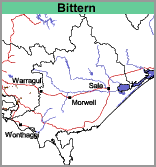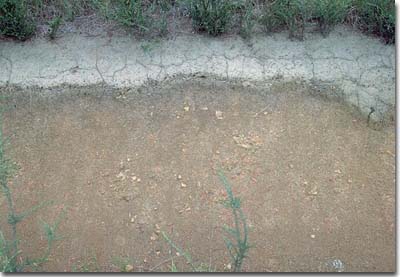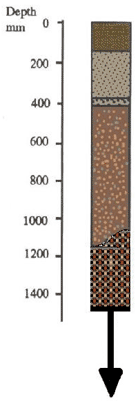Bittern (Bi)
 |
Geology
Tertiary period sediments (sandstones).
Landform
Gently undulating rises. The original late Tertiary land surface is now weakly dissected and the present landscape is gently undulating rises to gently undulating plains with slopes generally less than 3%.
Soils
Most of the surface soils are dark brownish grey to dark greyish brown sandy loams to clay loams overlying a bleached similarly textured zone generally containing iron oxide nodules (ironstone gravel) just above the clay. This clay occurs abruptly between about 300 mm to 500 mm and is a mottled yellowish brown, light grey and red-brown medium clay or sandy clay. Clays or sandy clays continue until the weakly cemented rock is encountered. On the rises this may be within 1 m of the surface. These soils can generally be regarded as Chromosols using the new Australian Soil Classification system (Isbell 1996). Site GP22 is an example of this soil type.
 Road cutting near Clyde showing a typical soil (Bittern sandy loam) formed on Tertiary sandstone (referred to as 'Baxter Sandstone' on geological maps). Note the presence of a bleached subsurface (A2) horizon and accumulation of 'ironstone' nodules at the A/B horizon boundary. |
In some areas, the surface and the bleached zone above the clay are deeper and more sandy. These soils are delineated on the map by the inscription "deep sandy surface phase" and are described next. They are similar to Toomuc sandy loam but differ in that they occupy higher positions in the landscape.
Typical Profile of a Bittern Sandy Loam
 | 0 - 150 mm. Dark brownish grey sandy* loam to clay loam. Clear transition to: 150 - 400 mm. Pale brownish grey fine sandy loam to clay loam. Ironstone gravel concretions above the clay. Abrupt transition to: 400 mm continuing. Mottled yellowish brown and grey with red-brown medium clay generally becoming sandier with depth. Mottled red-brown, yellow-brown and grey soft sandstone generally occurs before 1.5 m on the low rises. * The soil profile may contain some coarse sand. |
Land Use
Most of the area of this soil type supports improved pasture but is increasingly being used for market gardening. When dry, these soils tend to be form hard clods after cultivation. They also tend to become waterlogged after prolonged wet periods.
Although these soils may be cultivated for horticulture (mainly vegetables), the "spewy" nature of the bleached zone makes cultivation difficult when the soil is wet. Sub-surface drainage is generally required if vegetables are to be grown all year round.


